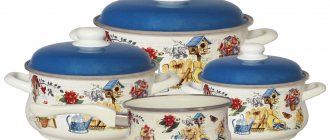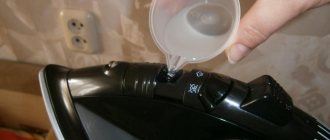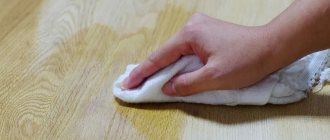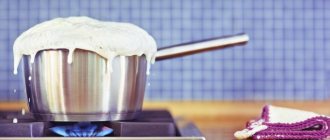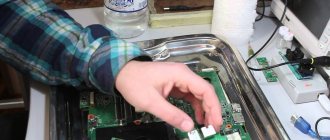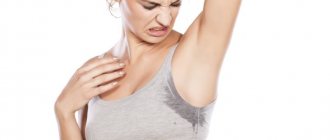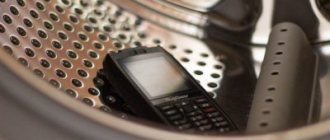To maintain the functionality and presentable appearance of the dishes, it is important to properly care for them. Do not leave containers dirty, try to clean the pan from burnt food in a timely manner. To avoid damaging the coating, when choosing a product, consider the material from which the bottom is made. The second significant factor is the thickness of the plaque and its age. The longer the owner waits, the more difficult it is to return the product to its original appearance.
How to clean a pan from burnt porridge
Everyone is familiar with situations when a pan, in which there was not enough water or the fire on the surface of the stove turned out to be much larger than required, is tightly connected to the cereal. Although initially it was planned to simply cook tasty and healthy porridge.
You can wash a burnt pan and the contents that have burned on it; you will need to use the following means:
- Clean the pan using this method:
- first remove the burnt contents with a washcloth;
- after the container has cooled, add a liter of water and a tablespoon of salt;
- boil the composition;
- treat the inner walls and bottom with vinegar and soda applied to a dish sponge.
- Enameled dishes require a special approach to solving the problem of how to clean a pan from burnt porridge. The fact is that any scratching compounds can violate the integrity of the enamel and spoil the product. Therefore, the most rational way to clean them is the following option:
- soak the container in cool water;
- Wipe the bottom thoroughly using a soft fiber sponge;
- If the previous steps did not produce results, boil a liter of water and a tablespoon of any detergent in a burnt pan.
- Ceramic dishes can easily be removed from the remains of burnt porridge; you just need to soak them in cool water for a while.
- Pans made of aluminum alloys are more difficult to clean because the burning area can become deformed and take on irregular shapes. It is best to avoid such situations, and if they occur, boil a liter of salt water in a bowl, and then try to carefully clean the carbon deposits with a soft washcloth.
- The ideal material is stainless steel, which is not at all afraid of burnt porridge, because it can be easily wiped off with a sponge of any hardness using a cleaning agent.
Process Features
The correct approach to work will not only allow you to quickly clean kitchen utensils, but will also preserve their durability. Therefore, it is important to use the “right” means and methods. Different metals react differently to cleaning agents. For example, acid damages enamel, and the use of abrasives is contraindicated for all types of non-stick coatings. Each type of material has its own rules of care - both effective and gentle.
There are many powerful agents that can cope with carbon deposits. To make their work easier, some housewives use oven cleaning products and grease solvents. Unicum, Sanita, Schumanit (Bagi), Oven Cleaner (Amway), and Velikan (Bagi) are considered to be products that effectively remove stubborn grease stains. It is worth noting that at the same time they are one of the most poisonous cleaning products, so it is not recommended to use them frequently. Work with them with gloves, with the window open, and most importantly, rinse the dishes thoroughly, eliminating the remnants of the detergent itself.
When choosing a cleaning product, you should consider the material from which the pan is made
How to clean a pan from burnt food at home
Salt is the first assistant in the fight against pollution.
Most often, women use store-bought formulas for washing dishes, but home remedies can help solve the problem of how to clean a burnt pan just as effectively.
- Salt is almost always used; it must be mixed with water, and then thoroughly boil the resulting composition. If you don’t want to boil it, you can simply keep the solution in the container for 3 hours, then thoroughly wash the container using a washcloth.
- Activated carbon will do a great job of removing burnt food in pots made from different materials. You need to use it like this:
- Grind 4-5 tablets to a powder;
- Apply this composition generously to the soiled elements of the dishes and leave for up to one hour;
- then add cold water and leave the container for half an hour;
- After that, wash off the carbon deposits with any detergent.
- Citric acid or ordinary vinegar will quickly and easily remove traces of plaque from the pan and help wash away burnt sugar. You need to use these tools like this:
- pour the liquid onto the burnt surface and leave it like that for 2–3 hours;
- Now you can wash off the remaining carbon deposits with a sponge.
- You can remove traces of rice that has stuck to the dishes by pouring whey into it and leaving it for a day. The acids contained in this drink dissolve plaque quite well and make it easy to clean even without the use of abrasives.
- Pots made of different materials can be washed using liquid soap, which must be poured into a container and boiled for half an hour. As a rule, this method works excellent if the burning is not too severe.
- To clean enamel surfaces, you can put sour-tasting apple peels in a container and leave for a while.
Special means
Household chemical stores sell many special products that can remove complex stains. They are used if traditional methods are ineffective.
The most popular types:
Cillit Bang: just apply the mixture to the bottom, wait about ten minutes and rinse the pan. There won't even be a trace left of the soot.- Sanita-gel. This product is based on alkali. It is used according to the same principle as Cillit Bang.
- Schumanite is a product that can clean ovens, baking sheets and burnt pans. When using it, you must follow safety precautions and be sure to wear gloves.
The choice of special means should be approached as responsibly as possible. If cleaning is carried out incorrectly, there is a risk of damage to the coating.
Manufacturers indicate on the packaging which kitchen utensils their products are suitable for. For example, Schumanite is prohibited from being used for cleaning aluminum products.
How to clean a pan from burnt milk
If the milk is burnt, baking soda will help clean the dishes.
Such a nuisance as milk that has burnt to the bottom of a pan or stove can not only ruin your mood, but also fill your apartment with a pungent odor that is not very easy to get rid of. That is why it is important to begin rescue measures immediately, without waiting for the aromas to spread throughout the home.
You need to wash a pan from burnt milk at home as follows:
- pour water into a container and place it on the stove over low heat for 30–40 minutes;
- add soda and leave the dishes to soak overnight;
- As a rule, in the morning, burnt milk can be easily cleaned from the surface.
Many housewives are happy to save dishes if they are burnt, using Pemolux or other store-bought products.
As a rule, they contain ordinary soda, flavored with some additives that soften burnt milk without any problems. Separately, it is worth noting this method of washing burnt milk:
- drip lemon juice onto the plaque and sprinkle it with soda;
- then wash the dishes with a regular cleaning product;
- This method will help not only remove dirt, but also whiten the enamel, giving it neatness.
Cleaning the external surface
It is often necessary to clean a burnt pan not only inside, but also outside due to frequent use. Regular dishwashing detergents can handle minor stains in the form of small deposits of soot and grease. But sometimes more complex options are required.
One of the common methods now is to boil pots and pans in larger dishes to remove external contaminants; it will also help to immediately clean the internal surface.
Please note right away that some methods contain alkali, which can destroy the coating of the dishes (for example, Teflon). You should also pay attention to plastic and wooden parts in the form of side handles or those on the lid. Below are the folk methods used by experienced housewives.
Baking soda and salt
These 2 types of product are found in every kitchen and are quite capable of coping with dirt, both on the surface of the dishes and inside. They are popular not only because of their low price, but also because of their ease of use. You can try to remove very small deposits by rubbing it with soda using a sponge.
If this does not help, then you should choose 1 of 2 methods described below:
- You need to moisten a sponge in warm water, apply a small amount of one of the substances, rub all problem areas and leave for 30 minutes. for soaking. After this, you need to rub a little and rinse under the tap. This is often enough to remove small deposits.
- More complex contaminants require high temperatures. To do this, you need to dilute 1 pack of salt or ½ pack of soda in 5 liters of water, lower the utensils there and put them on the stove. After boiling, you should monitor the amount of liquid that should completely cover the pan, and turn off the heat after 1.5 hours. All that remains is to let it cool and clean the surface in the usual way.
To prevent white residue from remaining, you need to thoroughly rinse the dishes at the end of processing.
Mustard powder
Mustard powder is capable of breaking down fats and is more suitable for light soot. It should be used in the form of a self-prepared paste. To do this, you just need to dilute it with warm water to a cream state, apply a thin layer to the surface of the kitchen utensils and wait about 20 minutes.
Vinegar
When the housewife does not have time to care for the outside of the pots, it is enough to wipe them with a 9% acetic acid solution.
Old stains need to be soaked, left in a ventilated area for at least 3.5 hours. Boiling is also allowed, for which ½ tbsp should be diluted in a large container. the drug in 5 liters of water, add a little shavings of laundry soap and heat for 1 hour on the stove.
Activated carbon
Activated carbon, which can be easily purchased at a pharmacy, will help clean a burnt pan. It is sold in the form of tablets; they must first be crushed directly in a package or in a mortar, then diluted with warm water to form a paste. Housewives apply this dark composition to contaminated areas and let it sit for 30-40 minutes, and then rinse a little or wash in the usual way.
Hydrogen peroxide
Hydrogen peroxide helps to cope even with old stains on pans. This will require digestion, that is, you need to dilute 200 ml of the prepared solution in 5 liters of water in a larger container with the addition of a small amount of detergent.
Then dip the kitchen utensils completely into it and boil over low heat for 1 hour. All that remains is to let it cool a little and rinse with running water to make sure the result.
Stationery glue
The composition of liquid glass (chemical name) includes potassium, lithium and silicates, which can destroy even old dirt. If you don't have stationery glue, you can use PVA. Each of the products is almost always mixed with soda ash or baking soda to enhance the effect.
There are 2 ways to clean kitchen utensils, which are suitable for different types of dirt:
- Soak. This type of procedure is suitable for light surface deposits on all kitchen utensils. In addition to pots, you can immediately place other dishes in the bathroom (for example, yellowed plates and salad bowls). It is necessary to fill a container with hot water, in which to dissolve office glue and baking soda in equal proportions. For 10 liters of liquid you will need 200 g of each composition. You will get a mixture with white flakes; immerse kitchen utensils in it for 40 minutes. After the allotted time, it is enough to rinse the dishes with running water using a sponge or brush.
- Digestion . This process is required for more stubborn stains and you need to find a container that will easily fit the entire pan. It should be filled with liquid to such an extent that it completely covers the surface of the dishes being processed. For a solution of 5 liters you need to use 100 g of glue, 150 g of soda.
The boiling time depends on the degree of contamination and ranges from 10 minutes. up to 1 hour. Further rinsing should be carried out only after the liquid has cooled.
Laundry soap
Laundry soap has long been famous for its ability to remove dirt.
How to clean a burnt pan? This can be done using office glue and laundry soap.
But for cleaning the outside of pots, as an independent product, it is rarely used, since it will not remove heavy carbon deposits. It is better to grate it using a regular vegetable grater and add it to other described solutions, thereby enhancing the cleaning effect.
Lemon juice
Lemon juice or citric acid diluted with water has similar properties to vinegar for treating the outside of pots. That is, it is more often used to add shine and remove light plaque. To do this, just wipe the surface of the dishes with it and rinse.
Digestion will help enhance the effect, but then you will need to add laundry soap to the composition.
Coca Cola
The popular drink, which was created for human consumption, even copes with old stains that have covered the pan with a thick layer. It is enough to pour Coca-Cola over small deposits for a couple of minutes so that they completely disappear, or use boiling in a large bowl to remove stubborn scale.
Cleaning pots with craft glue
Ordinary glue, which can be found in every desk, can work real miracles with burnt dishes. You can use it as follows:
- prepare a cleaning composition by mixing 10 liters of water, a bottle of liquid glue, a glass of soda ash and a bar of ordinary laundry soap;
- bring this mass to a boil;
- cook the pots in the mixture for at least 15 minutes, but no more than 3 hours;
- then turn off the stove and leave the dishes in the container with glue, allowing them to cool;
- Now you can treat the surface of the pans with a washcloth or sponge, removing all unattractive soot from them.
Separately, it should be noted that it is not recommended to wash Teflon dishes in this way.
Vinegar
Regular vinegar can clean carbon deposits well. The affected areas are generously watered with vinegar and left for a couple of hours. During this time, the vinegar will break down all the dirt, and you can wash everything almost effortlessly. But keep in mind that this method is completely unsuitable for aluminum.
If you can't find vinegar, you can replace it with lemon juice. It is cut and rubbed on the affected areas, and after 3 hours the container is washed. If you can’t wash off the dirt right away, the procedure can be repeated.
How to clean a pan from burnt jam
Fruits and berries that are boiled in sugar syrup often leave a darkish coating on the surface of the dishes, which is why the question of how to clean a pan from burnt jam does not lose its relevance and is especially acute in summer and autumn.
You can get rid of this trouble if you follow these tips:
- remove the product from the burnt container;
- after the dishes have cooled, fill them with water, to which you can add a little soda or dishwashing liquid;
- As a rule, jam that is burnt lags behind after such exposure after 15 minutes;
- if the effect is not visible, you can leave the burnt pan with this mixture overnight, and then try to scrub it off.
Separately, it is necessary to note measures to save dishes made from various materials.
- Aluminum cookware or stainless steel:
- Do not use abrasives or hard sponges;
- Citric acid diluted in water, which needs to be boiled in a container for 15 minutes, will do an excellent job of removing stains;
- soda mixed with silicate glue is boiled for 30 minutes, after which the soot and food residues come off almost by themselves.
- How to clean jam from ceramic dishes? You can try this method:
- sprinkle the bottom of such a pan with salt;
- leave the container for an hour;
- finally, you can pour water with citric acid and soda;
- then wash the pan with cool water.
- Enameled pans can be washed from burnt jam as follows:
- there is no need to fill such dishes with cold water, so as not to cause sugar to stick to the walls;
- you can boil a liter of water and soda (citric acid) in it;
- In addition, vinegar has a good effect on burnt sugar, but it leaves behind a pungent odor.
Teflon burns extremely rarely because it is a structure to which food does not easily stick. However, if such a problem arises, it is best to soak half an apple or lemon in a bowl. Fruits placed in water will release acid, which will dissolve contaminants.
Cleaning pots made of different materials
The cleaning method directly depends on the material used to make the dishes. Cast iron pans are the most durable; they can be scrubbed with hard sponges and scraped with a knife. Other types of containers require more delicate cleaning.
Enameled
Enamel is a durable material, but must be handled with care. Under no circumstances should you use:
- abrasives;
- metal brushes and sponges;
- other crude devices.
The burnt bottom of an enamel pan can be cleaned using both household chemicals and effective folk remedies:
- Soda. 5 tbsp. l. powder is poured with hot water and mixed. The solution is poured into a dirty container. To remove dark deposits and food residues, the dishes should be left overnight and then cleaned as usual.
- Sour apples. The contaminated surface is rubbed with an apple slice and left for a while. Then the pan is washed under the tap.
Tips for the correct use of enamel pans:
- make only liquid dishes and drinks in them;
- do not cook porridge or roast, which will definitely burn;
- Sudden temperature changes should not be allowed;
- You need to place a container filled with liquid on the fire, but not empty.
Important! Do not try to remove carbon deposits with sharp objects (fork, knife). This can permanently damage the coating.
Stainless steel
Rules for using stainless steel cookware:
- do not leave dirty, wash every time after use;
- It is better not to use a dishwasher;
- to avoid the appearance of stains on the surface after washing, you need to wipe the pan dry;
- Do not use hard tools for cleaning as they can scratch the dishes.
Ways to deal with soot:
We recommend:
How to wash felt-tip pen from clothes
- Soap solution. This method will only remove fresh dirt. Soap shavings or a small amount of dishwashing detergent are dissolved in water, and the mixture is poured into a container. After several hours, the carbon deposits can be easily removed with a sponge.
- Coca Cola. The drink is poured into a saucepan and brought to a boil. After some time, the liquid is drained, the dishes are washed under running water and wiped dry.
Important! Salt is harmful to stainless steel.
Made of aluminum
The soft alloy absorbs coal particles, as a result, the burnt food sticks tightly to the bottom. Hard brushes and sponges are not suitable for removing carbon deposits from the surface of aluminum. Special chemical compounds and folk remedies will be effective:
- Glue. If the contamination is old and very voluminous, and other means have not helped, this method will help get rid of burnt marks. Several liters of water are boiled in a saucepan, a couple of teaspoons of PVA and grated laundry soap (⅓ of a piece) are poured into it. The pan is tightly closed with a lid, the whole mixture is boiled for a little less than an hour.
- Dishwasher tablet. Water is poured into the pan until it covers the entire burnt area. After adding the tablet, the mixture is brought to a boil and simmered for about half an hour.
Other types
The only cookware that is suitable for mechanical cleaning is cast iron. To do this you will need a knife, a metal sponge and boiling water. To increase efficiency, you can heat the pan to 200 degrees to melt the fat. After cooling, the dishes are immersed in hot soapy water, and all the carbon deposits are scraped off with a knife. Residues are removed with a steel wool.
How to clean a pan from yellow deposits
You can get rid of yellowness on the pan using coffee grounds.
The yellowish soot that forms on the surface of pots as a result of not washing them too thoroughly can ruin the appearance of the most expensive set of dishes. To prevent this situation, it is advisable to clean the dishes at least once a week using a mild abrasive agent suitable for this type of container.
In addition, the following home remedies work well with yellow plaque:
- cleaning the walls of dishes with coffee grounds;
- a frying pan soaked in vinegar can be easily and quickly cleaned of yellowness;
- the composition “Persol”, boiled in a saucepan, is considered the optimal method of cleansing;
- 1/2 tablespoon of citric acid can quickly remove yellow plaque;
- you can add “Whiteness”, which you use to wash your plumbing fixtures; it also works well with kitchen utensils, although it requires careful rinsing of the dishes.
A housewife who does not want her dishes to become covered with a yellow coating will promptly clean them from household contaminants and dry them thoroughly, putting them away for storage.
Tips and tricks
To help you wash your kitchen utensils much less often, first of all, do not leave them unattended on the stove. Forgetfulness and absent-mindedness of the housewife leads to unpleasant consequences, which then need to be eliminated. Use a few tips to make cleaning the kitchen easier:
- Wash the pan after each cooking with dishwashing detergent or laundry soap;
- use only clean rags and sponges for washing;
- Before using cleaning powder, first apply it to an inconspicuous area of the metal and wait a little. The environment should not be aggressive towards the material;
- Always clean the pan from the inside and outside.
Aluminum cookware can be easily restored to its original attractive appearance and shine if it is regularly and properly cared for. This pan will serve you for many more years, use it for its intended purpose and wash it promptly.
We also recommend that you learn how to clean a frying pan from carbon deposits inside and out.
How to clean the outside of a pan from grease
In the kitchen, there are often cases when, due to working with dirty, greasy hands, yellowish traces of a rather dense consistency remain on the surface of the dishes, which are not so easy to remove with just a foam sponge.
It is best to use one of the methods described below:
- A mixture of a tablespoon of PVA glue and a third of laundry soap diluted in water works just fine. You need to use it like this:
- grate laundry soap and mix it with the rest of the ingredients;
- Boil the resulting mixture in a saucepan.
- Cleaning the surface of dishes with soda ash gives good results, but you will have to spend a little time and effort, although the result achieved will be worth it. Note! Not all surfaces can be treated this way.
- Salt, which is stirred in water and the dishes are boiled in this solution for an hour, will help clean enamel and aluminum from treacherous deposits on the surface.
- Any dishes, except enamel ones, can be cleaned with citric acid or vinegar. You need to soak the item that requires washing in such a solution, and after an hour it will remove all dirt.
- If the stains are old, remove them with a detergent, of which there are many on the shelves of hardware stores. The following brands work most effectively: “Shumanit”, “Chister” and the “Amway” product line.
What is not recommended for washing and cleaning the pan?
Stainless steel pans are not recommended to be washed:
- products not intended for cleaning stainless steel pans;
- aggressive agents that can scratch stainless steel.
It is also not recommended to wash dishes with various chemicals with bare hands. Since this can lead to various allergic reactions.
Metal scrapers and sponges
Soft sponges and washcloths are used to clean stainless steel cookware. But metal brushes and scrapers are not suitable for this. Because they leave scratches on the products.
Tip: It is best to wash stainless steel dishes with soft napkins or sponges using gentle circular movements.
Unsuitable household chemicals
Stainless steel dishes should not be washed with aggressive abrasive substances. Since they can leave scratches on the walls.
How to wash caramel from a pan
Caramel that clings to the surface of pans is nothing more than burnt sugar. Therefore, the methods for getting rid of it are similar to those described in the section on washing pans from burnt jam. Ridding them of this pollution seems to be a very difficult task, but quite solvable.
You can use the following tools:
- the Teflon coating easily separates from the caramel, you just need to fill it with a large amount of water with the addition of a detergent, and then rinse thoroughly;
- An aluminum surface can be washed by using boiling silicate glue in combination with laundry soap and citric acid or soda, and polishing the surface with a few drops of ammonia will also help.
Precautionary measures
The use of any cleaning products, including household ones, requires careful handling. Vinegar and ammonia combined with hot water produce unpleasant fumes. When using strong chemicals, you should take care of ventilation in advance, work with gloves and a respirator (toxic fumes actively affect the respiratory system and stomach). In addition, before starting work, you should carefully read the instructions for use of the drug - this will help you apply the product in the exact dosage and in the correct way. Before you wash a pan with a burnt bottom, you can read the reviews.
Don't despair if your favorite pan burns. Traditional methods and effective chemical compounds will come to the rescue, which will return it to its original appearance. “Grandmother’s” methods are safer, so it’s worth starting with them.
How to clean a pan from burnt rice
Onions will help clean the surface of the pan.
Probably every woman has wondered how to clean a burnt pan from grains of rice stuck to it. This cereal tends to quickly absorb water, so it’s easy not to keep track of it and miss an important moment when the water was still in the pan and suddenly disappeared.
When the need arises to clean a product from burnt rice, scraping off its particles from the surface immediately comes to mind. However, this method cannot be called rational, because it is very easy to damage the coating. To prevent this, you can use the following means:
- boiling ammonia;
- cleaning the surface with onions;
- fill the bottom with vinegar and leave it like that for 2-3 hours;
- boil a few slices or the peel of a sour apple in such a bowl;
- pour the whey into the container and leave it to act for a day; the grains of rice will fall away by themselves;
- Dilute the soap in water and pour it into the container, after 20–30 minutes the carbon deposits will begin to come off.
How to remove smoke using folk remedies?
It is quite difficult to clean off burnt composition immediately . In order not to damage the pan itself, it is first advisable to fill the affected container with water and let it stand. This will soften the burnt layer, and it will be much easier to remove it.
Boiling
This method is the simplest, but often shows itself to be ineffective when food is significantly burned.
Procedure:
- fill the container with water so that the water covers all affected areas with some reserve;
- boil;
- cool;
- repeat the treatment 2-3 times.
If, after several boilings, carbon deposits still remain, you can remove the softened layer with a dish sponge.
Salt
For light stains, when the bottom of the pan is not very burnt, you can use regular kitchen salt. It is poured into a pan in a thick layer and left to act for 5-8 hours . After this, clean with a hard sponge. Wash the pan in the usual way with gel.
A concentrated saline solution will help remove burnt food from the pan.
How to use:
- Prepare a salt solution based on 5 tablespoons per liter of water. The liquid should cover all burnt areas, including on the walls of the dish.
- Place the pan on the fire.
- Boil for 1-1.5 hours.
- Cool.
- Treat with a sponge, removing softened carbon deposits.
Boiling with salt will give a more pronounced effect than dry application, but is not able to cope with advanced cases and old contamination.
Soda
Baking soda is an alkaline agent that can be used to remove burnt spots on the bottom of a pan.
Procedure:
- prepare a cleaning solution at the rate of 0.5 cups of powder per liter of water;
- put on fire;
- boil for at least 60 minutes;
- cool;
- clean with a kitchen sponge.
Soda-vinegar solution
For processing, it is necessary to prepare a concentrated solution of table vinegar, diluted in half with water. The solution is poured into a saucepan and brought to a boil. After removing from heat, add soda with a tablespoon. You need to add enough powder to form an extensive foam.
The pan is left to stand while the reaction takes place . After the foam settles, mechanical cleaning will proceed faster, as the carbon deposits will soften, and in some places even move away from the bottom and walls.
For old burns, the treatment must be repeated several times, preparing a fresh solution for each procedure.
Soda and peroxide
Adding peroxide will help enhance the effect of soda. For use, a composition is prepared at the rate of 3 parts baking soda to 2 parts water.
Usage:
- The resulting preparation is used to treat areas affected by burnt food.
- Leave to act for a quarter of an hour.
- Rubbing with a hard sponge.
Vinegar
Table vinegar can be used in several ways:
- in its pure form;
- in the form of an aqueous solution;
- with additional boiling.
Using vinegar requires good ventilation, this is especially important when using methods with heated solution.
Vinegar is used as follows:
- Pour the liquid directly from the bottle into the pan. It can be left alone or diluted with water in a ratio of 1:1 or 1:2.
- Heat, but do not bring to a boil.
- Leave for several hours.
- Clean the pan with a stiff sponge.
Heating is a factor that enhances the effects of acetic acid.
Activated carbon
The use of pharmaceutical activated carbon will help remove small stains, but not cope with old ones.
For processing, you need to remove the tablets from the package and grind them to a powder state. The number of tablets depends on the size of the burnt area.
Application:
- black powder obtained from tablets is poured onto the bottom so as to cover the affected areas;
- the pan is infused for several hours;
- water is added - enough is needed to cover all the stains;
- leave the pan for another hour and a half;
- cleaning with a sponge.
Mustard powder
Using mustard powder helps keep the bottom and walls of the pan clean. But this method will not overcome the burnt layer of porridge or jam.
Apply mustard to a damp sponge and rub the stained areas . The resulting cleaning slurry helps remove small, older stains.
You can enhance the effect by mixing mustard powder with soda and pre-rubbing the bottom of the pan with the mixture.
Serum
The lactic acid in the whey will help clean off burnt-on food. The product is poured into the pan in sufficient quantity to cover the burn marks. The minimum layer of liquid poured is from 20 mm.
Cover the pan with a lid and leave for several hours . During this time, the acid will soften the deposit, which will allow it to be removed without damaging the base material.
Apples, lemon
After burnt porridge, you can clean the pan using fresh apples. You need to choose fruits of sour varieties. A similar result can be obtained using lemons.
Procedure:
- Cut the apples into large pieces.
- Place in a saucepan.
- To fill with water.
- Boil for 30-60 minutes.
The more apples there are, and the more sour they are, the higher the effect due to the presence of fruit acid in the fruit.
Toothpaste
A non-standard use of toothpaste is for scrubbing burnt areas inside the pan. This method will give a good effect when the contamination is fresh. The paste is squeezed onto a sponge or directly into the pan and rubbed with the hard side.
Coca Cola
Coca-Cola can be used
to remove burnt marks .
The drink is poured into the affected pan and left to act for several hours. After this, rub with the hard side of the sponge.
The effect of the drink is due to the inclusion of carbon dioxide and phosphoric acid in its composition.
What to do if the pan is very burnt from the inside
Activated carbon tablets are a safe and effective dish cleaner.
There are often cases when the housewife is distracted by something, and the food that was being prepared completely sticks to the coating.
Let's try to figure out how to clean a burnt pan below:
- using a saline solution, which must be poured into a container and left for a while;
- pour acetic acid onto the burnt surface;
- Soda dissolved in water and boiled over medium heat works well. This leads to the fact that carbon deposits are easily wiped off;
- crushed activated carbon tablets will remove milky buildup;
- food will come off easily if you rub the remaining coffee grounds into the surface;
- The inside of the pan can be scrubbed if you first fill it with Coca-Cola and let it stand for an hour or two;
- using store-bought cleaning products.
The most important rule is to never place an empty pan on a hot stove.
To avoid such problems, you should follow some cooking rules:
- if the dishes are new, you need to boil water in it and let the latter cool in the container, thereby hardening the surface;
- do not put an empty pan on the fire;
- do not pour cold water onto a hot surface;
- Handle the utensils with care, avoiding damage.
Rules for caring for a stainless steel pan
In order for stainless steel cookware to last as long as possible, it is necessary to properly care for it:
- after each use, it is washed with well-selected products and a sufficient amount of water;
- It is necessary to wash the dishes only after they have completely cooled down;
- cleaning stainless steel with aggressive and abrasive substances is strictly prohibited;
- It is not advisable to wash stainless steel in the dishwasher;
- After washing, the products are wiped dry with a cloth. This can avoid streaks and stains.
The main rule when caring for stainless steel pots is to wash them regularly and keep them clean.
How to clean the inside of a pan from darkening
Most often, the question of how to clean a pan from burnt jam gives rise to a counter question: how to get rid of dark deposits on the inner walls. The most effective methods for removing such a nuisance are the following:
- a concentrated salt solution, boiled in a container, cleans the coating well;
- white sea sand, with some time, allows you to manually remove all darkening both inside and outside;
- citric acid can not only remove scale, but also dark stains; it must be diluted with water and boiled for half an hour;
- Vinegar has a similar effect;
- baking soda applied to the surface and diluted with water can remove even very dark carbon deposits.
To summarize, it should be noted that with just vinegar, soda and salt on hand, you can cope with most problems with burnt dishes. However, in order not to waste your time on such washing, it is better to closely monitor the cooking process and promptly remove any dirt that has arisen, preventing it from drying out.
What not to do and why?
When cleaning a burnt pan, you must remember the following prohibitions:
You should not use cleaning products that are not intended for use on dishes, as this can be harmful not only to the pan, but also to your health.- Do not clean with bare hands - you will need protective rubber gloves.
- Intensive mechanical cleaning methods should not be used as they may damage the surface.
- The type of coating material should not be ignored. You need to choose methods of influence only taking into account the material, so as not to completely ruin the pan.
Baking soda
Suitable for materials: stainless steel, cast iron, enamel.
Type of soot: porridge, sugar, pasta, milk, jam.
Instructions:
- Place the pot or pan in a larger container.
- Pour in so that it covers the product by a few centimeters.
- Add baking soda in a proportion of 0.5 kg per 5 liters of water.
- Boil for 2 hours.
- Cool and remove any remaining dirt.
Before boiling, remove plastic parts to avoid damage.
Video - how to clean a non-stick frying pan
Reasons for burning porridge
The main reason for the formation of carbon deposits is unsuitable cookware. To prevent the porridge from burning, you need one of these pans:
- ceramic;
- Teflon;
- stainless.
But Teflon and stainless steel are also not a solution, because the coating only protects until it gets scratched. And the sharp edges of grains and grains leave many micro-scratches, no matter how carefully the housewife works.
Other causes of burning:
- thin bottom (in pans with this “problem” the porridge can burn even with a protective layer);
- non-compliance with the recipe (recommended volume of water and milk per amount of cereal).
Pollution prevention
To prevent contamination, it is recommended to carefully monitor the cleanliness of dishes. It is important to wash it immediately after cooking, choose the right detergents, and never leave cleaning pans after food has burned in them until later.
To summarize, it is worth noting that a stainless steel pan can be washed from fat, soot, and carbon deposits not only with the help of purchased household chemicals, but also with folk remedies that are always at hand in the household.
Related Posts
How to clean a dishwasher at home
Organization of storage in the kitchen in cabinets
How to remove odor from the refrigerator: what to wash and clean to remove the unpleasant odor
How to clean spoons and forks at home until they shine
Useful care tips
To maintain the appearance of enamel cookware, you need to follow some simple rules.
- A new pan cannot be used without first hardening the enamel. To do this, you just need to pour warm water into the pan, let it boil a little, then remove from the heat and let it cool. This is how the enamel is hardened.
- Cookware with chipped enamel is unsuitable for use.
- Enameled dishes are not used for frying (some housewives manage to do this, for example, cook frying in a pan).
- It is advisable not to boil milk and not to use an enamel-coated pan for cooking milk porridges. Milk is not the best product for them; it often burns.
- To keep the enamel as long as possible, you should avoid temperature changes: do not place it from a hot surface to a cold one, and use only water at room temperature for soaking.
- Substances with large abrasive particles or a metal brush are not applicable to their surface - if the coating is damaged, the pan becomes unsuitable for further use.
- When working with enamel cookware, you need to avoid sudden movements: do not drop it, do not place it sharply on the table, because the enamel tends to chip easily.
